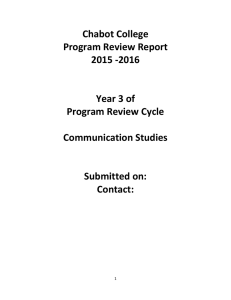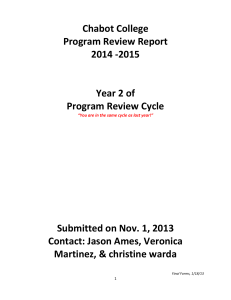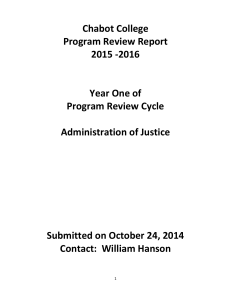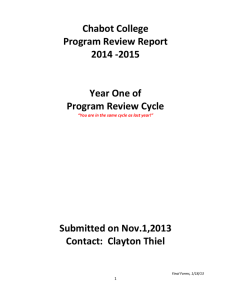Chabot College Program Review Report 2015 ‐2016
advertisement
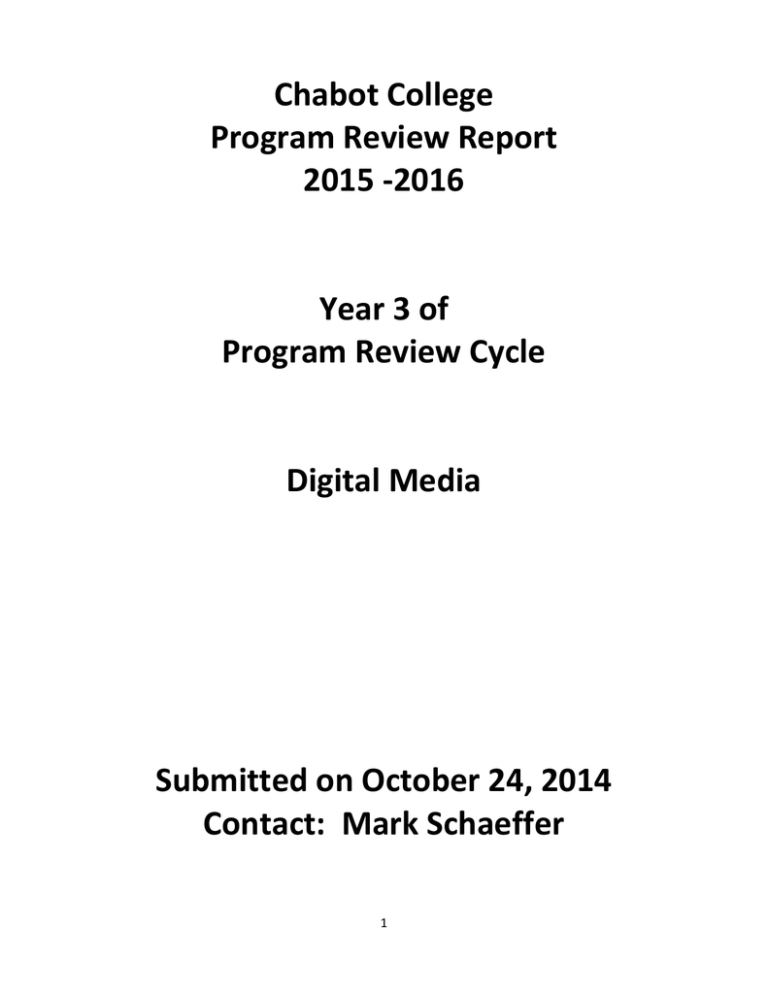
Chabot College Program Review Report 2015 ‐2016 Year 3 of Program Review Cycle Digital Media Submitted on October 24, 2014 Contact: Mark Schaeffer 1 Appendix B2: “Closing the Loop” Course‐Level Assessment Reflections. Course DIGM 31A Semester assessment data gathered Fall 2013 Number of sections offered in the semester 1 Number of sections assessed 1 Percentage of sections assessed 100% Semester held “Closing the Loop” discussion Spring 2014 Faculty members involved in “Closing the Loop” discussion Mark Schaeffer Form Instructions: Complete a separate Appendix B2 form for each Course‐Level assessment reported in this Program Review. These courses should be listed in Appendix B1: Student Learning Outcomes Assessment Reporting Schedule. Part I: CLO Data Reporting. For each CLO, obtain Class Achievement data in aggregate for all sections assessed in eLumen. Part II: CLO Reflections. Based on student success reported in Part I, reflect on the individual CLO. Part III: Course Reflection. In reviewing all the CLOs and your findings, reflect on the course as a whole. PART I: COURSE‐LEVEL OUTCOMES – DATA RESULTS CONSIDER THE COURSE‐LEVEL OUTCOMES INDIVIDUALLY (THE NUMBER OF CLOS WILL DIFFER BY COURSE) (CLO) 1: Use Adobe Photoshop to create a satisfying image (CLO) 2: (CLO) 3: (CLO) 4: Defined Target Scores* (CLO Goal) NA (No target defined) Actual Scores** (eLumen data) NA If more CLOs are listed for the course, add another row to the table. * Defined Target Scores:What scores in eLumen from your students would indicate success for this CLO? (Example: 75% of the class scored either 3 or 4) **Actual scores: What is the actual percent of students that meet defined target based on the eLumen data collected in this assessment cycle? 2 PART II: COURSE‐ LEVEL OUTCOME REFLECTIONS A. COURSE‐LEVEL OUTCOME (CLO) 1: 1. How do your current scores match with your above target for student success in this course level outcome? CLO scores are irrelevant to success. Each student comes in with his or her own goals for the course; all that is relevant is whether that student met those goals. 2. Reflection: Based on the data gathered, and considering your teaching experiences and your discussions with other faculty, what reflections and insights do you have? The quality of students’ work depends mostly on their reasons for taking the course. Those who intend to use Photoshop professionally in an arts‐related career tend to put in more effort, and therefore do better. Those who are taking the course simply out of curiosity, or because they think it might be fun, or because they want to use it for non‐job‐related reasons, tend to put their effort elsewhere and therefore don’t do as well. How much value learning Photoshop has to them, and how much work it makes sense to put into it, is up to the student, not to me. B. COURSE‐LEVEL OUTCOME (CLO) 2: 1. How do your current scores match with your above target for student success in this course level outcome? 2. Reflection: Based on the data gathered, and considering your teaching experiences and your discussions with other faculty, what reflections and insights do you have? 3 C. COURSE‐LEVEL OUTCOME (CLO) 3: 1. How do your current scores match with your above target for student success in this course level outcome? 2. Reflection: Based on the data gathered, and considering your teaching experiences and your discussions with other faculty, what reflections and insights do you have? D. COURSE‐LEVEL OUTCOME (CLO) 4: 1. How do your current scores match with your above target for student success in this course level outcome? 2. Reflection: Based on the data gathered, and considering your teaching experiences and your discussions with other faculty, what reflections and insights do you have? E. COURSE‐LEVEL OUTCOME (CLO) 5: ADD IF NEEDED. 4 PART III: COURSE REFLECTIONS AND FUTURE PLANS 1. What changes were made to your course based on the previous assessment cycle, the prior Closing the Loop reflections and other faculty discussions? Regardless of how students do in the course, I am always making changes. As technology changes, the course content changes, and my strategies for presenting it change as well. Therefore, I can’t make useful comparisons from one assessment cycle to the next. 2. Based on the current assessment and reflections, what course‐level and programmatic strengths have the assessment reflections revealed? What actions has your discipline determined might be taken as a result of your reflections, discussions, and insights? NA 3. What is the nature of the planned actions (please check all that apply)? Curricular Pedagogical Resource based Change to CLO or rubric Change to assessment methods Other:___NA___________________________________________________________ ✓ 5 Appendix B2: “Closing the Loop” Course‐Level Assessment Reflections. Course DIGM 31B Semester assessment data gathered Fall 2013 Number of sections offered in the semester 1 Number of sections assessed 1 Percentage of sections assessed 100% Semester held “Closing the Loop” discussion Spring 2014 Faculty members involved in “Closing the Loop” discussion Mark Schaeffer Form Instructions: Complete a separate Appendix B2 form for each Course‐Level assessment reported in this Program Review. These courses should be listed in Appendix B1: Student Learning Outcomes Assessment Reporting Schedule. Part I: CLO Data Reporting. For each CLO, obtain Class Achievement data in aggregate for all sections assessed in eLumen. Part II: CLO Reflections. Based on student success reported in Part I, reflect on the individual CLO. Part III: Course Reflection. In reviewing all the CLOs and your findings, reflect on the course as a whole. PART I: COURSE‐LEVEL OUTCOMES – DATA RESULTS CONSIDER THE COURSE‐LEVEL OUTCOMES INDIVIDUALLY (THE NUMBER OF CLOS WILL DIFFER BY COURSE) (CLO) 1: Use Adobe Photoshop to create a satisfying image (CLO) 2: (CLO) 3: (CLO) 4: Defined Target Scores* (CLO Goal) NA (No target defined) Actual Scores** (eLumen data) NA If more CLOs are listed for the course, add another row to the table. * Defined Target Scores:What scores in eLumen from your students would indicate success for this CLO? (Example: 75% of the class scored either 3 or 4) **Actual scores: What is the actual percent of students that meet defined target based on the eLumen data collected in this assessment cycle? 6 PART II: COURSE‐ LEVEL OUTCOME REFLECTIONS C. COURSE‐LEVEL OUTCOME (CLO) 1: 3. How do your current scores match with your above target for student success in this course level outcome? CLO scores are irrelevant to success. Each student comes in with his or her own goals for the course; all that is relevant is whether that student met those goals. 4. Reflection: Based on the data gathered, and considering your teaching experiences and your discussions with other faculty, what reflections and insights do you have? The quality of students’ work depends mostly on their reasons for taking the course. Those who intend to use Photoshop professionally in an arts‐related career tend to put in more effort, and therefore do better. Those who are taking the course simply out of curiosity, or because they think it might be fun, or because they want to use it for non‐job‐related reasons, tend to put their effort elsewhere and therefore don’t do as well. How much value learning Photoshop has to them, and how much work it makes sense to put into it, is up to the student, not to me. D. COURSE‐LEVEL OUTCOME (CLO) 2: 3. How do your current scores match with your above target for student success in this course level outcome? 4. Reflection: Based on the data gathered, and considering your teaching experiences and your discussions with other faculty, what reflections and insights do you have? 7 C. COURSE‐LEVEL OUTCOME (CLO) 3: 3. How do your current scores match with your above target for student success in this course level outcome? 4. Reflection: Based on the data gathered, and considering your teaching experiences and your discussions with other faculty, what reflections and insights do you have? D. COURSE‐LEVEL OUTCOME (CLO) 4: 3. How do your current scores match with your above target for student success in this course level outcome? 4. Reflection: Based on the data gathered, and considering your teaching experiences and your discussions with other faculty, what reflections and insights do you have? E. COURSE‐LEVEL OUTCOME (CLO) 5: ADD IF NEEDED. 8 PART III: COURSE REFLECTIONS AND FUTURE PLANS 4. What changes were made to your course based on the previous assessment cycle, the prior Closing the Loop reflections and other faculty discussions? Regardless of how students do in the course, I am always making changes. As technology changes, the course content changes, and my strategies for presenting it change as well. Therefore, I can’t make useful comparisons from one assessment cycle to the next. 5. Based on the current assessment and reflections, what course‐level and programmatic strengths have the assessment reflections revealed? What actions has your discipline determined might be taken as a result of your reflections, discussions, and insights? NA 6. What is the nature of the planned actions (please check all that apply)? Curricular Pedagogical Resource based Change to CLO or rubric Change to assessment methods Other:___NA___________________________________________________________ ✓ 9 Appendix B2: “Closing the Loop” Course‐Level Assessment Reflections. Course DIGM 34 Semester assessment data gathered Spring 2014 Number of sections offered in the semester 1 Number of sections assessed 1 Percentage of sections assessed 100% Semester held “Closing the Loop” discussion Fall 2014 Faculty members involved in “Closing the Loop” discussion Mark Schaeffer Form Instructions: Complete a separate Appendix B2 form for each Course‐Level assessment reported in this Program Review. These courses should be listed in Appendix B1: Student Learning Outcomes Assessment Reporting Schedule. Part I: CLO Data Reporting. For each CLO, obtain Class Achievement data in aggregate for all sections assessed in eLumen. Part II: CLO Reflections. Based on student success reported in Part I, reflect on the individual CLO. Part III: Course Reflection. In reviewing all the CLOs and your findings, reflect on the course as a whole. PART I: COURSE‐LEVEL OUTCOMES – DATA RESULTS CONSIDER THE COURSE‐LEVEL OUTCOMES INDIVIDUALLY (THE NUMBER OF CLOS WILL DIFFER BY COURSE) (CLO) 1: Use JavaScript to create an interactive environment on a web page (CLO) 2: (CLO) 3: (CLO) 4: Defined Target Scores* (CLO Goal) NA (No target defined) Actual Scores** (eLumen data) NA If more CLOs are listed for the course, add another row to the table. * Defined Target Scores:What scores in eLumen from your students would indicate success for this CLO? (Example: 75% of the class scored either 3 or 4) **Actual scores: What is the actual percent of students that meet defined target based on the eLumen data collected in this assessment cycle? 10 PART II: COURSE‐ LEVEL OUTCOME REFLECTIONS E. COURSE‐LEVEL OUTCOME (CLO) 1: 5. How do your current scores match with your above target for student success in this course level outcome? CLO scores are irrelevant to success. Each student comes in with his or her own goals for the course; all that is relevant is whether that student met those goals. 6. Reflection: Based on the data gathered, and considering your teaching experiences and your discussions with other faculty, what reflections and insights do you have? To my knowledge, none of the students in the class plan on using JavaScript professionally. The purpose of the course is not for students to become JavaScript programmers, but to understand the capabilities of JavaScript and take them into account when they do their design work. Therefore, the quality of their JavaScript programming doesn’t matter very much; what matters is that they face the challenges that JavaScript presents. Everyone in the class faced those challenges with energy and determination F. COURSE‐LEVEL OUTCOME (CLO) 2: 5. How do your current scores match with your above target for student success in this course level outcome? 6. Reflection: Based on the data gathered, and considering your teaching experiences and your discussions with other faculty, what reflections and insights do you have? 11 C. COURSE‐LEVEL OUTCOME (CLO) 3: 5. How do your current scores match with your above target for student success in this course level outcome? 6. Reflection: Based on the data gathered, and considering your teaching experiences and your discussions with other faculty, what reflections and insights do you have? D. COURSE‐LEVEL OUTCOME (CLO) 4: 5. How do your current scores match with your above target for student success in this course level outcome? 6. Reflection: Based on the data gathered, and considering your teaching experiences and your discussions with other faculty, what reflections and insights do you have? E. COURSE‐LEVEL OUTCOME (CLO) 5: ADD IF NEEDED. 12 PART III: COURSE REFLECTIONS AND FUTURE PLANS 7. What changes were made to your course based on the previous assessment cycle, the prior Closing the Loop reflections and other faculty discussions? The course has only been offered once so far. 8. Based on the current assessment and reflections, what course‐level and programmatic strengths have the assessment reflections revealed? What actions has your discipline determined might be taken as a result of your reflections, discussions, and insights? I plan to present topics in a slightly different sequence, not following the order of the textbook chapters quite as slavishly. ✓ 9. What is the nature of the planned actions (please check all that apply)? Curricular Pedagogical Resource based Change to CLO or rubric Change to assessment methods Other:______________________________________________________________ 13 Appendix C: Program Learning Outcomes Considering your feedback, findings, and/or information that has arisen from the course level discussions, please reflect on each of your Program Level Outcomes. Program: _Digital Media Certificate__ PLO #1: Use the tools available in one or more types of digital media to create a satisfying piece of work PLO #2: Demonstrate a professional attitude in the preparation and completion of work PLO #3: PLO #4: What questions or investigations arose as a result of these reflections or discussions? None What program‐level strengths have the assessment reflections revealed? None What actions has your discipline determined might be taken to enhance the learning of students completing your program? Curricular changes have been made, but these are in response to developments in technology that are unrelated to PLOs Program: _____ PLO #1: PLO #2: PLO #3: PLO #4: What questions or investigations arose as a result of these reflections or discussions? 14 What program‐level strengths have the assessment reflections revealed? What actions has your discipline determined might be taken to enhance the learning of students completing your program? 15
